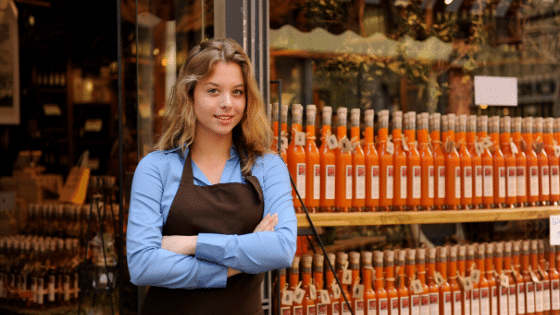As a retailer, you’re bound to experience high and low seasons.
Periods of slower sales can happen for many reasons such as natural seasonality (e.g. Halloween supplies), the weather, or competitive promotions. Whatever the reason for your slump, it’s important to view your off-season or slow periods as a potential opportunity.
Low seasons are actually the perfect time for retailers to focus on their marketing efforts. With a little bit of creativity and planning, you can make it through your off-season with not only more new customers, but a larger base of followers to promote to. And who knows, you may even find a new revenue opportunity in the process!
Keep reading for 3 strategies that you can use to keep your retail business profitable during your slow periods.
Why an off-season marketing strategy is important
There is a common misconception that businesses should only invest in marketing during their high season. But this isn’t the case. Your slower seasons are actually the time when you need the sales lift from marketing!
In particular, an off-season marketing strategy is key to:
- Building local and online awareness: Knowing is half the battle. Shoppers don’t know what they’ve never seen. Marketing during the off-season gives your retail business time to build online presence and brand awareness with target shoppers. You can educate customers on what your store has to offer and how you are better than your competition. This way, once your peak season hits, you will be top-of-mind with shoppers.
- Minimizing your overall marketing costs: Ad spend decreases during the off-season as less competitors are bidding on ad space. This means that you can get more exposure at a lower cost versus advertising during your high season.
- Getting ahead of your competitors: Besides getting new shoppers in your door, marketing during the off-season also gives you the opportunity to start building your own mailing lists or followers. This is particularly important as you need time to attract a following of people interested in what you offer. But by starting earlier than your competitors, you will be ahead of them by having a new list of potential shoppers that you can market directly to during your high season.
3 marketing strategies for the off-season
When we’re talking about marketing, we are specifically talking about digital marketing. While traditional marketing has its place, for most privately owned businesses, digital marketing offers the easiest way to promote your business, especially during your off-season. After all, today’s average shopper now spends more time with digital content than traditional media.
1) Gather online customer reviews

Online reviews are an important part of the consumer shopping journey. In fact, 90% of shoppers read customer reviews before visiting a business. And according to Google, 2 out of 3 shoppers say having positive reviews was an important factor in selecting a business or store to purchase from.
With so many people basing their purchasing decisions on reviews, gathering reviews should be a key marketing strategy for your business all year round. But the off-season is usually the best time to ask loyal and long term shoppers to leave a review on your Google My Business (GMB) profile, especially now that you can create a GMB shortname unique to your business. You can then use customer reviews as promotional material across all of your digital platforms including your social media and store website. By staying active online and promoting positive customer testimonials, shoppers will remember your retail business when peak season hits.
2) Consider paid marketing options

Digital marketing benefits retailers of all sizes as it is always the fastest way to cost-effectively access an incredibly targeted audience of shoppers. The advantages of digital marketing include:
- Fast impact: Compared to traditional marketing, paid digital marketing will make an impact much faster. Depending on the type of campaign, you can get up and running in minutes.
- Flexible and accountable: The results of digital marketing are much easier to see so you can immediately know whether a campaign is working and make changes right away. This is a major difference from traditional marketing where your investment is a one-time deal since you can’t make changes once a flyer or a radio ad is printed or produced.
- Lower overall cost: A well planned out digital marketing campaign can reach a targeted audience at a much lower cost (as little as $10/day) than traditional marketing methods.
Click here to learn more about the benefits of digital marketing for retailers.
Run Google Local Inventory Ads (LIA)
Over the past several years, an increasing number of retailers have looked at running Google Local Inventory Ads (LIA) during slower periods. In Sidecar‘s 2019 Benchmark Report: Google Ads in Retail, the LIA performance of several retailers was examined. It turns out, LIA clicks grew by 16% and revenue increased 15% year-over-year.
Sephora, Canadian Tire, and Williams-Sonoma are some of the big box retailers who have seen success with Google LIA. Now for the first time ever, Local Inventory Ads are also available to independent retailers who are looking to attract local shoppers. And the best part? They are available in an automated way that doesn’t require retailers to hire new staff or keep inventory stock levels updated.
To learn how you can easily implement Google LIA together with your POS system, click here.
While Google LIA has proven to be a viable marketing strategy all year round, it is particularly effective during off-season for the following reasons:
- Bids are lower: As mentioned above, there are fewer competitors buying ads during off-season – which means lower ad spend is required to gain impressions.
- Marketing costs are minimized: LIA only showcases in-stock product and will automatically turn off when stock runs out, reducing your marketing costs.
- Get in front of local shoppers who are actually looking to purchase your products: Google LIA displays in-stock product to shoppers within a certain Km radius (you have full control over the geographical range) who are actually searching for products that your store sells.
3) Promote your business on social media

With the rise in social media and e-commerce, shoppers are closer than ever to retail businesses. Not only do you have a way to directly showcase your products and store, you can now build up your list of followers for personalized offers.
While websites are still a great way to offer a “digital window” into your store, with the rise in social commerce (e.g. Facebook Shops, Instagram Shopping, etc.), it’s very important for retail stores to be active on social media.
Check out these 6 tips to help you grow your social following more quickly during your low season:
- Pick no more than 1 or 2 social media platforms to avoid spreading yourself too thin. Just make sure you’re picking ones your target customers commonly use. See how the various social media platforms differ.
- Make sure you have a verified Google My Business (GMB) account and are active on it. GMB is one of the best free online marketing tools available for small businesses today. Not only does GMB help local shoppers find you on Google Maps, it has options for you to post content (e.g. special offers or events) which improves your SEO.
- Improve your content design with cost-effective graphic tools. You don’t need to be a designer to use drag-and-drop tools such as Canva that even have free versions.
- Use original images for the best results as these rank better on SEO.
- Don’t forget to include the links to your social media accounts on email signatures, invoices, receipts, ads and on any window displays.
- Clearly display your social media links at the cash register and train your staff to encourage shoppers to sign up for special offers while they are waiting.
Did you find this article helpful?
Sign up for blog updates in our footer below to learn more about the latest in retail marketing and point-of-sale technology.
#retail #retailmarketing #attractlocalshoppers #retailpos #cloudpos #digitalmarketing #offseason #marketing


